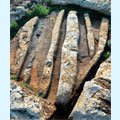ABORIGINE CULTURE.
 The origin of the first dwellers of the Canary Islands was in Northern Africa and presents natural and various contrasts with the later level of economic and social development.
The origin of the first dwellers of the Canary Islands was in Northern Africa and presents natural and various contrasts with the later level of economic and social development.
Islands such as Gran Canaria , for example, achieved a certain degree of agricultural development sooner than the rest of the archipelago, while their beliefs were as varied as they were complex.
The use of caves as dwellings – and not only as a storehouse for agricultural tools or as a stable – is still a constant in the Canary Islands, an aboriginal cultural heritage that was well versed in the advantages of digging rooms in the depths of the mountains when the surrounding environment was favourable.
 Precisely in Gran Canaria is where the largest integrated settlements can be found almost completely of cave-homes, such as in Artenara, Bermeja Cave (Cueva Bermeja), in Guayadeque, La Atalaya de Santa Brígida, Hoya de Pineda and several others.
Precisely in Gran Canaria is where the largest integrated settlements can be found almost completely of cave-homes, such as in Artenara, Bermeja Cave (Cueva Bermeja), in Guayadeque, La Atalaya de Santa Brígida, Hoya de Pineda and several others.
This more or less idyllic world experimented quite a rude shock with European culture at the beginning of the XV century. The first dwellers of all the islands had a similar culture, but with time, their isolation brought about their disappearance, although evidences remain of that remote common origin.